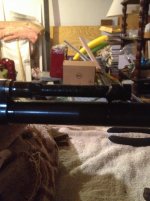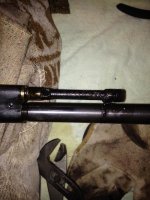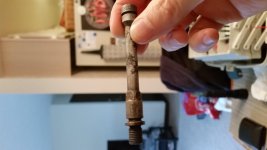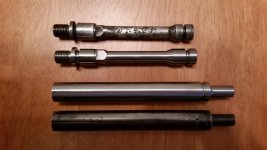Hello there,
I'm also in the process of restoring my grandfather's G-43, and had/have the same issue; the gas cylinder cap was frozen onto the piston. I must say I like the original poster's rig for soaking the entire piston in penetrating oil, and I think that anyone with a similar problem will quickly discover that it's almost impossible to find Kano Kroil (penetrating oil) sold anywhere other than Amazon or their website, so in my case, I've been using Liquid Wrench. I've also heard people sing praises for PB Blaster, so, if you're impatient like me, you aught to be able to find either the LW or PB at most Lowes or Home Depots.
In regards to the makeup of the gas cylinder, the divot (as stated above), is supposed to be there; it's how the earlier models gas cylinder cap was manufactured, in two pieces. I had the same confusion when I watched a few g-43 breakdown videos via u-tube and saw a different design for the gas cylinder cap that was all one piece. This makes sense since at the time the German's were no doubt trying to find a simpler means to fabricate later model rifles using less material and fewer parts.
Regardless, I followed this advice in order to remove the gas cylinder cap: I plugged the barrel with cork (cleaning clothes will also do the trick) just past the gas block, then sprayed LW down the barrel and stood the rifle muzzle up and angled in such a way that the oil would flow through the gas port on the barrel through the gas block and into the piston and (hopefully) gas cylinder cap. I also doused the point where the piston cap was mating to the piston with oil as well, then used a very, very difficult technique: Patients.
After about a day or so of soaking, I discovered the same divot (which lead to my investigation), and also discovered that there was an ever so slight gap between the parts. What could I use to work penetrating oil into that gap?
Two things: The first was recommended; heating the tube with a propane torch, then dousing it in oil where the parts were mated (do not do this in an enclosed space without proper ventilation fyi), and then the second, which seems a bit unorthodox, but it worked:
Dental floss.
I found that I could douse the gap in oil, then slowly "saw" my way through the rust and cosmoline using the floss. Once I had enough of a gap exposed, I was able to stand the rifle on it's butt end, and using a piece of brass stock (because again, good luck finding brass punches sold anywhere other than online), and, with the piece of stock angle, I lightly began tapping downward on the gas cylinder and it moved! I kept at it and finally freed the two parts from one another!
What it exposed was a gas piston that is still in good shape, though slightly pitted with corrosion.
Now, here's where I could use some advice:
With the gas cylinder cap off, I quickly discovered that the piston is frozen into the gas block, and I'll be damned if I can get them free. For the moment, I've been applying heat to the gas block, then dousing it in LW in the hopes that the oil will eventually penetrate deeply enough to be able to separate the parts using a crescent wrench, but it's been several days of trying this process and I've made no forward progress. Does anyone have any suggestions?
Once freed, I'm planning on replacing the original piston with one of Rob Apfeltor's shooters kits. Thanks for any help you can provide.





